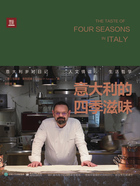
自序 Preface
身为厨师,最令我感到满足的事情就是,有幸能通过烹饪来感受大自然给予人们的美好馈赠,同时,借助自己的双手和想象力,使美好的食材与健康的美食结缘,将爱与专注融汇其中,为我们的家人、朋友或客人献上各种珍馐佳肴。在这本书里,您可以学到很多有趣的意大利饮食文化和家常食谱,了解美食背后那些有趣的故事。
食物有着一种特殊的魔力,能够将不同民族、不同地域、不同文化背景的人们聚集在一起,一同分享美味、趣闻和欢笑,生命中许多重要的和美好的时刻与回忆,常常就发生在餐桌上。
烹饪是交流,是记忆,是文化,又是历史。
我希望通过书中的文字与图片,您能够深入了解意大利传统菜肴、意大利饮食与文化,并通过饮食的脉络去了解意大利悠久的历史。我也希望把本书当作一个媒介,帮助人们分享美食,并创造美好的心境。
从传统意义上说,意大利饮食的关键元素是谷物、蔬菜、橄榄油和肉类。其中,面包、意大利面、番茄、蔬菜、橄榄油和奶酪是意大利菜的基本成分。同时,丰富而新鲜的香草,如迷迭香、罗勒、欧芹等,对意大利菜的烹调也起到了重要作用。
如果厨师对食材和传统食谱具有深刻的理解,并掌握了熟练的“厨艺语言”,就能制作出世界级的意大利风味美食。同时,厨师还可以假以当代最新时尚和创新手法来二次创新或重构一些百年经典食谱,利用现代烹饪技法使菜肴更清淡,更适合精致的味觉,这其中最重要的还是创新和创意,它们与传统可以完美地融汇相承。
美食是意大利饮食文化的核心,意大利人非常重视他们的饮食文化,一个典型的表现便是他们对食谱和烹饪技艺的痴迷。很多时候,你会看见意大利人热烈地讨论某道菜的起源以及正确烹饪方式,对食物的依恋早已注入到了意大利人的血液之中。未来,我的努力方向主要是:首先设法提升我的料理品质,同时尽可能地减少碳排放,减少对进口食材的依赖,增加本地食材的使用;其次还要注意保护环境,实现美食及其文化的可持续发展,通过自己的行动,保护环境、保护地球。
我很幸运,在过去的十五年里,见证了中国日新月异的发展历程。中国地大物博,我非常喜欢在料理中运用中国的本地食材,比如云南的香草和蔬菜,中国有些产地的鱼子酱品质比欧洲的更优。让我来举出一些实例:酱油、云南香菇、山东韭菜、黑龙江鱼子酱、新疆葡萄干和无花果、大连扇贝和海胆、厦门鱿鱼和小章鱼、山西醋、贵州黑猪肉、四川辣椒……这些美好的食材总能激励我创新和制作新的菜品,它们也能让您和我对未来怀有更多的期待。
Marino于北京
2020年7月
One of the most fulfilling things in a chef's life is the opportunity to work with the gifts that Mother Nature gives us. It is a joy to use our hands and our imagination to combine beautiful ingredients and prepare delicious dishes for our friends and family. In this book, you will discover some fun Italian family recipes, and the stories behind them.
Food has the power to bring people from different nations, regions and cultural backgrounds together. While we are enjoying a great meal, we can share stories and laughter. The dinner table sees many great moments and memories in our lives.
Cooking is communication, memory, culture, and history.
Through these recipes, I hope you will gain a better vision of traditional Italian dishes and culture, and will learn something about Italy's profound history. I hope this book will be a medium for people to share good food and good times together.
Traditionally, the key components of Italian cuisine are cereals, vegetables, olive oil, bread, pasta, tomatoes, and cheese are also fundamental ingredients. Fresh herbs such as rosemary, basil, and parsley also play an important role.
Italian cuisine can be executed at a world-class level when a chef has extensive knowledge of ingredients and traditional recipes. Meanwhile, with modern and creative techniques, chef can reinvite centuries-old recipes and make dishes taste lighter and more appealing to refined palates. Nevertheless, what matters most is retaining the spirit of the original recipe with creative ideas.
Food is the core of Italian culture. Italians are very attached to their regional recipes. Taking a typical example, they often get into heated arguments about the origin of a recipe and how to execute it in the most proper way. This respect and love for food is in our blood. I constantly try to improve the quality of my cooking and reduce my carbon footprint by switching out some imported ingredients for local ones. I pay attention to the environment and pursue the sustainable development and culture of Italian cuisine and protect the enviornment and our earth through my actions.
I feel so lucky that I have been able to witness some fascinating changes here in China over the past 15 years. With its vast territory and abundant resourses, China is now producing excellent local ingredients. For example, there is high-quality herbs and vegetables in Yunnan, and the local caviar is now better than European brands. To give a few more concrete examples, ingredients like soy sauce and mushrooms from Yunnan, leeks from Shandong, caviar from Heilongjiang, raisins and figs from Xinjiang, scallops and sea urchins from Dalian, squid and baby octopus from Xiamen, Shanxi vinegar, black pork from Guizhou, and even chilies from Sichuan... inspire me to do new research and create more dishes, I expect we will have many more ingredients to look forward to in the future.
Marino, Beijing
July, 2022